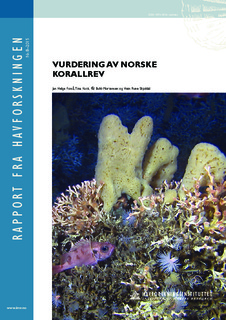| dc.description.abstract | In 1999, the Norwegian fisheries authorities established a regulation for the protection
of cold-water coral reefs, Lophelia pertusa, against damage from bottom trawling,
including: prohibition of intentional destruction, precaution when fishing in the
vicinity of known sites and, for certain locations, a total ban of bottom trawling. As of
today, there are nine areas that have received a species protection and where bottom
trawling is banned: Sula, Iverryggen, Røst, Tisler, Fjellknausene, Korallen, Træna,
Breisunddjupet and Rauerfjorden (for geographical coordinates see Appendix 2).
The present report is a response to a request from the Directorate of Fisheries to
“evaluate areas for protection of coral reefs”. The request included three tasks: 1)
Describe the distribution of reefs near by the protected sites on the background of new
knowledge. The directorate will use the information to consider whether or not the
present borders of the protected areas are appropriate. 2) Evaluate whether the nine
specific sites are representative for the reefs along the coast and offshore. 3) Consider
whether new sites can add to the total representativeness of protected reefs along the
coast and offshore. In this report the representativity of larger known Lophelia sites
has been evaluated based on a combination of growth form and geographical location.
The aim was to create a network of protected coral areas that covers most of the
different reef forms in each to four defined sub-coral provinces and seascapes along
the Norwegian coastline. The reef forms are (example site): 1) elongated or cigar-like
(Træna), 2) drop-like to elongated, with or without signs of sea-bed erosion at the reef
front facing the current (Breisunddjupet, Hola), 3) reef-complexes consisting of
hundreds or thousands of coral domes growing close to each other or merged together
(Sula), 4) single and circular of up to 50 m in height (Fugløya), 5) wall-reefs consist
of colonies growing on steep walls or on overhangs in fjords (Straumsneset), 6) hillreefs
grow in sloping terrain on the coast and in fjords, for example on sills of fjords
(Stjernsund). A last category (7) refers to their function: connectivity or bridgehead
that function as links between reefs in the Atlantic ocean and the Norwegian coast
through the transport of larvae (Storneset). In addition we divided the Norwegian sea
areas into three seascapes: 1) coast and the fjords, 2) continental shelf, 3) shelf brake
including the slope. The Norwegian coast boarders three seas: the North Sea with
Skagerrak, the Norwegian Sea and the Barents Sea. Although these regions are all
influenced by the North-East Atlantic water, they have distinctive physical conditions
that will, for instance, influence the connectivity between Lophelia in Norwegian
waters and the reefs further south-west in the Atlantic ocean. Our hypothesis is that
higher exposure of an area to the inflow of Atlantic water, the higher the connectivity
among reefs in the Atlantic Ocean and Norwegian waters. This hypothesis and the
general hydrographical situation are the basis for an identification of four Coral Subprovinces
along the Norwegian coast and shelf: Skagerrak, Vestlandet, Midt-Norge
and Nord-Norge. Within these sub-provinces, we suggest new sites that will add to
the representativeness of protected reefs. We also suggest to close at least one site in
each of the Coral Sub-provinces, against all fishing activities including long-line and
gill-net fishing. Once the fishing impact is removed, it will allow the study of other
impact factors, such as climate change and ocean acidification, which in turn will
make it easier to interpret the results of reef monitoring in the future. | nb_NO |
